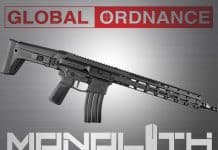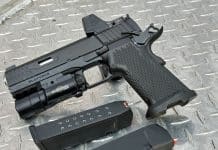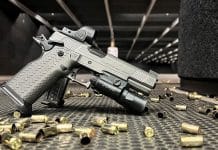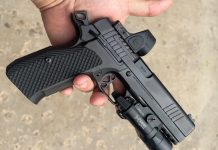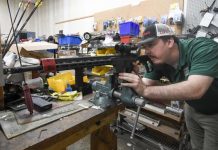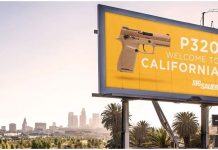David Kopel of davekopel.org wrote an article detailing and comparing modern gun control with revolutionary era gun control.
The American Revolution against British Gun Control
By David B. Kopel
Administrative and Regulatory Law News (American Bar Association). Vol. 37, no. 4, Summer 2012. More by Kopel on the right to arms in the Founding Era.
This Article reviews the British gun control program that precipitated the American Revolution: the 1774 import ban on firearms and gunpowder; the 1774-75 confiscations of firearms and gunpowder; and the use of violence to effectuate the confiscations. It was these events that changed a situation of political tension into a shooting war. Each of these British abuses provides insights into the scope of the modern Second Amendment.
Furious at the December 1773 Boston Tea Party, Parliament in 1774 passed the Coercive Acts. The particular provisions of the Coercive Acts were offensive to Americans, but it was the possibility that the British might deploy the army to enforce them that primed many colonists for armed resistance. The Patriots of Lancaster County, Pennsylvania, resolved: "That in the event of Great Britain attempting to force unjust laws upon us by the strength of arms, our cause we leave to heaven and our rifles." A South Carolina newspaper essay, reprinted in Virginia, urged that any law that had to be enforced by the military was necessarily illegitimate.
The Royal Governor of Massachusetts, General Thomas Gage, had forbidden town meetings from taking place more than once a year. When he dispatched the Redcoats to break up an illegal town meeting in Salem, 3000 armed Americans appeared in response, and the British retreated. Gage’s aide John Andrews explained that everyone in the area aged 16 years or older owned a gun and plenty of gunpowder.
Military rule would be difficult to impose on an armed populace. Gage had only 2,000 troops in Boston. There were thousands of armed men in Boston alone, and more in the surrounding area. One response to the problem was to deprive the Americans of gunpowder.
Modern "smokeless" gunpowder is stable under most conditions. The "black powder" of the 18th Century was far more volatile. Accordingly, large quantities of black powder were often stored in a town’s "powder house," typically a reinforced brick building. The powder house would hold merchants’ reserves, large quantities stored by individuals, as well as powder for use by the local militia. Although colonial laws generally required militiamen (and sometimes all householders, too) to have their own firearm and a minimum quantity of powder, not everyone could afford it. Consequently, the government sometimes supplied "public arms" and powder to individual militiamen. Policies varied on whether militiamen who had been given public arms would keep them at home. Public arms would often be stored in a special armory, which might also be the powder house.
Before dawn on September 1, 1774, 260 of Gage’s Redcoats sailed up the Mystic River and seized hundreds of barrels of powder from the Charlestown powder house.
The "Powder Alarm," as it became known, was a serious provocation. By the end of the day, 20,000 militiamen had mobilized and started marching towards Boston. In Connecticut and Western Massachusetts, rumors quickly spread that the Powder Alarm had actually involved fighting in the streets of Boston. More accurate reports reached the militia companies before that militia reached Boston, and so the war did not begin in September. The message, though, was unmistakable: If the British used violence to seize arms or powder, the Americans would treat that violent seizure as an act of war, and would fight. And that is exactly what happened several months later, on April 19, 1775.
Five days after the Powder Alarm, on September 6, the militia of the towns of Worcester County assembled on the Worcester Common. Backed by the formidable array, the Worcester Convention took over the reins of government, and ordered the resignations of all militia officers, who had received their commissions from the Royal Governor. The officers promptly resigned and then received new commissions from the Worcester Convention.
That same day, the people of Suffolk County (which includes Boston) assembled and adopted the Suffolk Resolves. The 19-point Resolves complained about the Powder Alarm, and then took control of the local militia away from the Royal Governor (by replacing the Governor’s appointed officers with officers elected by the militia) and resolved to engage in group practice with arms at least weekly.
The First Continental Congress, which had just assembled in Philadelphia, unanimously endorsed the Suffolk Resolves and urged all the other colonies to send supplies to help the Bostonians.
Governor Gage directed the Redcoats to begin general, warrantless searches for arms and ammunition. According to the Boston Gazette, of all General Gage’s offenses, "what most irritated the People" was "seizing their Arms and Ammunition."
When the Massachusetts Assembly convened, General Gage declared it illegal, so the representatives reassembled as the "Provincial Congress." On October 26, 1774, the Massachusetts Provincial Congress adopted a resolution condemning military rule, and criticizing Gage for "unlawfully seizing and retaining large quantities of ammunition in the arsenal at Boston." The Provincial Congress urged all militia companies to organize and elect their own officers. At least a quarter of the militia (the famous Minute Men) were directed to "equip and hold themselves in readiness to march at the shortest notice." The Provincial Congress further declared that everyone who did not already have a gun should get one, and start practicing with it diligently.
In flagrant defiance of royal authority, the Provincial Congress appointed a Committee of Safety and vested it with the power to call forth the militia. The militia of Massachusetts was now the instrument of what was becoming an independent government of Massachusetts.
Lord Dartmouth, the Royal Secretary of State for America, sent Gage a letter on October 17, 1774, urging him to disarm New England. Gage replied that he would like to do so, but it was impossible without the use of force. After Gage’s letter was made public by a reading in the British House of Commons, it was publicized in America as proof of Britain’s malign intentions.
Two days after Lord Dartmouth dispatched his disarmament recommendation, King George III and his ministers blocked importation of arms and ammunition to America. Read literally, the order merely required a permit to export arms or ammunition from Great Britain to America. In practice, no permits were granted.
Meanwhile, Benjamin Franklin was masterminding the surreptitious import of arms and ammunition from the Netherlands, France, and Spain.
The patriotic Boston Committee of Correspondence learned of the arms embargo and promptly dispatched Paul Revere to New Hampshire, with the warning that two British ships were headed to Fort William and Mary, near Portsmouth, New Hampshire, to seize firearms, cannons, and gunpowder. On December 14, 1774, 400 New Hampshire patriots preemptively captured all the material at the fort. A New Hampshire newspaper argued that the capture was prudent and proper, reminding readers that the ancient Carthaginians had consented to "deliver up all their Arms to the Romans" and were decimated by the Romans soon after.
In Parliament, a moderate minority favored conciliation with America. Among the moderates was the Duke of Manchester, who warned that America now had three million people, and most of them were trained to use arms. He was certain they could produce a stronger army than Great Britain.
The Massachusetts Provincial Congress offered to purchase as many arms and bayonets as could be delivered to the next session of the Congress. Massachusetts also urged American gunsmiths "diligently to apply themselves" to making guns for everyone who did not already have a gun. A few weeks earlier, the Congress had resolved: "That it be strongly recommended, to all the inhabitants of this colony, to be diligently attentive to learning the use of arms . . . ."
Derived from political and legal philosophers such as John Locke, Hugo Grotius, and Edward Coke, the ideology underlying all forms of American resistance was explicitly premised on the right of self-defense of all inalienable rights; from the self-defense foundation was constructed a political theory in which the people were the masters and government the servant, so that the people have the right to remove a disobedient servant.
The British government was not, in a purely formal sense, attempting to abolish the Americans’ common law right of self-defense. Yet in practice, that was precisely what the British were attempting. First, by disarming the Americans, the British were attempting to make the practical exercise of the right of personal self-defense much more difficult. Second, and more fundamentally, the Americans made no distinction between self-defense against a lone criminal or against a criminal government. To the Americans, and to their British Whig ancestors, the right of self-defense necessarily implied the right of armed self-defense against tyranny.
The troubles in New England inflamed the other colonies. Patrick Henry’s great speech to the Virginia legislature on March 23, 1775, argued that the British plainly meant to subjugate America by force. Because every attempt by the Americans at peaceful reconciliation had been rebuffed, the only remaining alternatives for the Americans were to accept slavery or to take up arms. If the Americans did not act soon, the British would soon disarm them, and all hope would be lost. "The millions of people, armed in the holy cause of liberty, and in such a country as that which we possess, are invincible by any force which our enemy can send against us," he promised.
The Convention formed a committee—including Patrick Henry, Richard Henry Lee, George Washington, and Thomas Jefferson—"to prepare a plan for the embodying, arming, and disciplining such a number of men as may be sufficient" to defend the commonwealth. The Convention urged "that every Man be provided with a good Rifle" and "that every Horseman be provided . . . with Pistols and Holsters, a Carbine, or other Firelock." When the Virginia militiamen assembled a few weeks later, many wore canvas hunting shirts adorned with the motto "Liberty or Death."
In South Carolina, patriots established a government, headed by the "General Committee." The Committee described the British arms embargo as a plot to disarm the Americans in order to enslave them. Thus, the Committee recommended that "all persons" should "immediately" provide themselves with a large quantity of ammunition.
Without formal legal authorization, Americans began to form independent militia, outside the traditional chain of command of the royal governors. In Virginia, George Washington and George Mason organized the Fairfax Independent Militia Company. The Fairfax militiamen pledged that "we will, each of us, constantly keep by us" a firelock, six pounds of gunpowder, and twenty pounds of lead. Other independent militia embodied in Virginia along the same model. Independent militia also formed in Connecticut, Rhode Island, New Hampshire, Maryland, and South Carolina, choosing their own officers.
John Adams praised the newly constituted Massachusetts militia, "commanded through the province, not by men who procured their commissions from a governor as a reward for making themselves pimps to his tools."
The American War of Independence began on April 19, 1775, when 700 Redcoats under the command of Major John Pitcairn left Boston to seize American arms at Lexington and Concord.
The militia that assembled at the Lexington Green and the Concord Bridge consisted of able-bodied men aged 16 to 60. They supplied their own firearms, although a few poor men had to borrow a gun. Warned by Paul Revere and Samuel Dawes of the British advance, the young women of Lexington assembled cartridges late into the evening of April 18.
At dawn, the British confronted about 200 militiamen at Lexington. "Disperse you Rebels—Damn you, throw down your Arms and disperse!" ordered Major Pitcairn. The Americans were quickly routed.
With a "huzzah" of victory, the Redcoats marched on to Concord, where one of Gage’s spies had told him that the largest Patriot reserve of gunpowder was stored. At Concord’s North Bridge, the town militia met with some of the British force, and after a battle of two or three minutes, drove off the British.
Notwithstanding the setback at the bridge, the Redcoats had sufficient force to search the town for arms and ammunition. But the main powder stores at Concord had been hauled to safety before the Redcoats arrived.
When the British began to withdraw back to Boston, things got much worse for them. Armed Americans were swarming in from nearby towns. They would soon outnumber the British 2:1. Although some of the Americans cohered in militia units, a great many fought on their own, taking sniper positions wherever opportunity presented itself. Only British reinforcements dispatched from Boston saved the British expedition from annihilation—and the fact that the Americans started running out of ammunition and gun powder.
One British officer reported: "These fellows were generally good marksmen, and many of them used long guns made for Duck-Shooting." On a per-shot basis, the Americans inflicted higher casualties than had the British regulars.
That night, the American militiamen began laying siege to Boston, where General Gage’s standing army was located. At dawn, Boston had been the base from which the King’s army could project force into New England. Now, it was trapped in the city, surrounded by people in arms.
Two days later in Virginia, royal authorities confiscated 20 barrels of gunpowder from the public magazine in Williamsburg and destroyed the public firearms there by removing their firing mechanisms. In response to complaints, manifested most visibly by the mustering of a large independent militia led by Patrick Henry, Governor Dunmore delivered a legal note promising to pay restitution.
At Lexington and Concord, forcible disarmament had not worked out for the British. So back in Boston, Gage set out to disarm the Bostonians a different way.
On April 23, 1775, Gage offered the Bostonians the opportunity to leave town if they surrendered their arms. The Boston Selectmen voted to accept the offer, and within days, 2,674 guns were deposited, one gun for every two adult male Bostonians.
Gage thought that many Bostonians still had guns, and he refused to allow the Bostonians to leave. Indeed, a large proportion of the surrendered guns were "training arms"—large muskets with bayonets, that would be difficult to hide. After several months, food shortages in Boston convinced Gage to allow easier emigration from the city.
Gage’s disarmament program incited other Americans to take up arms. Benjamin Franklin, returning to Philadelphia after an unsuccessful diplomatic trip to London, "was highly pleased to find the Americans arming and preparing for the worst events."
The government in London dispatched more troops and three more generals to America: William Howe, Henry Clinton, and John Burgoyne. The generals arrived on May 25, 1775, with orders from Lord Dartmouth to seize all arms in public armories, or which had been "secretly collected together for the purpose of aiding Rebellions."
The war underway, the Americans captured Fort Ticonderoga in upstate New York. At the June 17 Battle of Bunker Hill, the militia held its ground against the British regulars and inflicted heavy casualties, until they ran out of gunpowder and were finally driven back. (Had Gage not confiscated the gunpowder from the Charleston Powder House the previous September, the Battle of Bunker Hill probably would have resulted in an outright defeat of the British.)
On June 19, Gage renewed his demand that the Bostonians surrender their arms, and he declared that anyone found in possession of arms would be deemed guilty of treason.
Meanwhile, the Continental Congress had voted to send ten companies of riflemen from Pennsylvania, Maryland, and Virginia to aid the Massachusetts militia.
On July 6, 1775, the Continental Congress adopted the Declaration of Causes and Necessity of Taking Up Arms, written by Thomas Jefferson and the great Pennsylvania lawyer John Dickinson. Among the grievances were General Gage’s efforts to disarm the people of Lexington, Concord, and Boston.
Two days later, the Continental Congress sent an open letter to the people of Great Britain warning that "men trained to arms from their Infancy, and animated by the Love of Liberty, will afford neither a cheap or easy conquest."
The Swiss immigrant John Zubly, who was serving as a Georgia delegate to the Continental Congress, wrote a pamphlet entitled Great Britain’s Right to Tax . . . By a Swiss, which was published in London and Philadelphia. He warned that "in a strong sense of liberty, and the use of fire-arms almost from the cradle, the Americans have vastly the advantage over men of their rank almost every where else." Indeed, children were "shouldering the resemblance of a gun before they are well able to walk." "The Americans will fight like men, who have everything at stake," and their motto was "DEATH OR FREEDOM." The town of Gorham, Massachusetts (now part of the State of Maine), sent the British government a warning that even "many of our Women have been used to handle the Cartridge and load the Musquet."
It was feared that the Massachusetts gun confiscation was the prototype for the rest of America. For example, a newspaper article published in three colonies reported that when the new British generals arrived, they would order everyone in America "to deliver up their arms by a certain stipulated day."
The events of April 19 convinced many more Americans to arm themselves and to embody independent militia. A report from New York City observed that "the inhabitants there are arming themselves . . . forming companies, and taking every method to defend our rights. The like spirit prevails in the province of New Jersey, where a large and well disciplined militia are now fit for action."
In Virginia, Lord Dunmore observed: "Every County is now Arming a Company of men whom they call an independent Company for the avowed purpose of protecting their Committee, and to be employed against Government if occasion require." North Carolina’s Royal Governor Josiah Martin issued a proclamation outlawing independent militia, but it had little effect.
A Virginia gentleman wrote a letter to a Scottish friend explaining in America:
We are all in arms, exercising and training old and young to the use of the gun. No person goes abroad without his sword, or gun, or pistols. . . . Every plain is full of armed men, who all wear a hunting shirt, on the left breast of which are sewed, in very legible letters, "Liberty or Death."
The British escalated the war. Royal Admiral Samuel Graves ordered that all seaports north of Boston be burned.
When the British navy showed up at what was then known as Falmouth, Massachusetts (today’s Portland, Maine), the town attempted to negotiate. The townspeople gave up eight muskets, which was hardly sufficient, and so Falmouth was destroyed by naval bombardment.
The next year, the 13 Colonies would adopt the Declaration of Independence. The Declaration listed the tyrannical acts of King George III, including his methods for carrying out gun control: "He has plundered our seas, ravaged our Coasts, burnt our Towns, and destroyed the Lives of our people."
As the war went on, the British always remembered that without gun control, they could never control America. In 1777, with British victory seeming likely, Colonial Undersecretary William Knox drafted a plan entitled "What Is Fit to Be Done with America?" To ensure that there would be no future rebellions, "[t]he Militia Laws should be repealed and none suffered to be re-enacted, & the Arms of all the People should be taken away, . . . nor should any Foundery or manufactuary of Arms, Gunpowder, or Warlike Stores, be ever suffered in America, nor should any Gunpowder, Lead, Arms or Ordnance be imported into it without Licence . . . ."
To the Americans of the Revolution and the Founding Era, the theory of some late-20th Century courts that the Second Amendment is a "collective right" and not an "individual right" might have seemed incomprehensible. The Americans owned guns individually, in their homes. They owned guns collectively, in their town armories and powder houses. They would not allow the British to confiscate their individual arms, nor their collective arms; and when the British tried to do both, the Revolution began. The Americans used their individual arms and their collective arms to fight against the confiscation of any arms. Americans fought to provide themselves a government that would never perpetrate the abuses that had provoked the Revolution.
What are modern versions of such abuses? The reaction against the 1774 import ban for firearms and gunpowder (via a discretionary licensing law) indicates that import restrictions are unconstitutional if their purpose is to make it more difficult for Americans to possess guns. The federal Gun Control Act of 1968 prohibits the import of any firearm that is not deemed “sporting” by federal regulators. That import ban seems difficult to justify based on the historical record of 1774-76.
Laws disarming people who have proven themselves to be a particular threat to public safety are not implicated by the 1774-76 experience. In contrast, laws that aim to disarm the public at large are precisely what turned a political argument into the American Revolution.
The most important lesson for today from the Revolution is about militaristic or violent search and seizure in the name of disarmament. As Hurricane Katrina bore down on Louisiana, police officers in St. Charles Parish confiscated firearms from people who were attempting to flee. After the hurricane passed, officers went house to house in New Orleans, breaking into homes and confiscating firearms at gunpoint. The firearms seizures were flagrantly illegal under existing state law. A federal district judge soon issued an order against the confiscation, ordering the return of the seized guns.
When there is genuine evidence of potential danger—such as evidence that guns are in the possession of a violent gang—then the Fourth Amendment properly allows no-knock raids, flash-bang grenades, and similar violent tactics to carry out a search. Conversely, if there is no real evidence of danger—for example, if it is believed that a person who has no record of violence owns guns but has not registered them properly—then militaristically violent enforcement of a search warrant should never be allowed. Gun ownership simpliciter ought never to be a pretext for government violence. The Americans in 1775 fought a war because the king did not agree.
Research Director, Independence Institute, and Adjunct Professor of Advanced Constitutional Law, Denver University, Sturm College of Law. This is article is adapted from How the British Gun Control Program Precipitated the American Revolution, 6 Charleston L. Rev. 283 (2012), available at http://ssrn.com/abstract=1967702.
* The views and opinions expressed on this web site are solely those of the original authors and contributors. These views and opinions do not necessarily represent those of Guns & Tactics Magazine,
the administrative staff, and/or any/all contributors to this site.



